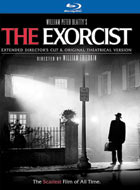BLU-RAY REVIEW

Exorcist, The
Featured In Issue 152, December 2010
The Extended Director's Cut is the theatrically re-released (Autumn of 2000) version that offers eleven minutes of additional footage, including the scary and much talked-about "spider walk." A tale of possession that shocked millions, "The Exorcist" won Academy Awards® for Best Adapted Screenplay and Sound. Regan (Blair), a 12-year-old girl, is either suffering from a severe neurological disorder or, worse, has been possessed by an evil spirit. Chris (Burstyn), her desperate mother, knows there is something deeper—more terrible—than what doctors and psychiatrists believe and seeks help from the doubtful, intelligent Father Karras (Miller) and the dedicated Jesuit exorcist, Father Merrin (von Sydow). (Laurie Sevano)
The two-disc Extended Director's Cut Edition of The Exorcist features on Disc One the Extended Director's Cut (02:12:21) and on Disc Two the original theatrical version (02:01:55). Special features on Disc One include commentary by Director William Friedkin, a three-part documentary on the movie's production and legacy: "Raising Hell: Filming The Exorcist" (HD 30:03), "The Exorcist Locations: Georgetown Then And Now" (HD 08:30), and "Faces Of Evil: The Different Versions Of The Exorcist" (HD 09:52); two theatrical trailers (HD 03:38); three TV spots (HD 01:22); and two radio spots (01:39). Special features on Disc Two include an introduction by Friedkin; commentary by Friedkin; commentary by William Peter Blatty with sound effects tests; Sketches & Storyboards, with an interview gallery with Friedkin and Blatty covering the topics "The Original Cut, "The Final Reckoning," and "Stairway To Heaven" (HD 09:02); the original ending (HD 01:42); the making-of featurette: "The Fear Of God" (HD 01:17:09); three theatrical trailers (HD 03:54); and four TV spots (HD 03:10). The package includes a personal message from Friedkin and a 40-page booklet
The 1080p VC-1 picture quality is absolutely first rate and distinguishes this edition as the definitive presentation of the two versions. First reviewed in Issue 26, the 1.78:1 letterbox component anamorphic picture quality was mediocre, with dated color fidelity that was sometimes natural and other times plugged up with brownish fleshtones and undefined blacks. Sharpness and detail was wanting and shadow detail exhibited poor delineation. Background noise was apparent, and scenes were occasionally marred with artifacts. The 1.78:1 anamorphically enhanced 25th anniversary special edition DVD reviewed in Issue 31 appeared to be the same transfer as the anamorphically enhanced DVD reviewed in Issue 26. The DVD picture was sometimes natural with vibrant colors and natural fleshtones, and other times plugged up with brownish fleshtones and undefined blacks. Images at times were extremely sharp and detailed, while other times wanting. By comparison, the original LaserDisc review, while exhibiting slightly darker colors, was softly focused. All three versions exhibited background noise and artifacts, but the DVDs were preferred. The 1.78:1 version reviewed in Issue 47 exhibited some nice improvements. For example, the opening scenes of the dig in Iraq were quite gritty, with excessive film grain and artifacts. The dust flying into the sky created a distracting horizon of grain and dirt that was minimized by a smoother, blue sky on the new DVD. Much of the picture was very similar to the previous version, with some grain reduction for a smoother image. The slightly dated colors were well balanced with full saturation, though, occasionally a bit muddy. Blacks were a bit weak. Fine details were nicely rendered at times, and the overall picture was generally sharp. The darker scenes occasionally exhibited mediocre shadow delineation. Some minor edge enhancement was noticed, but was infrequent and not much of a distraction. Pixelization was occasional, and while dirt, artifacts, and film grain were noticed, the picture was generally pleasing for its age. This latest Blu-ray Disc™ release, containing both the extended director's cut and the original theatrical version, feature completely restored and remastered 1080p VC-1 transfers. The previous faults are no longer evident, or at least greatly minimized, to be non-objectable. Cinematographer Owen Roizman personalized the transfers to insure that the ominous shadowy atmospheric imagery is properly conveyed. The color palette is impressively saturated and perfectly balanced, as is contrast, with deep blacks and revealing shadow delineation. Dimensionality is excellent. Fleshtones are naturally rendered. Remarkably, the source print and transfer reveal stunning resolution. Fine textures are well resolved, especially during close-ups of facial features and object textures. The image quality is impressively pristine and fresh appearing. At times the imagery displays a soft presence with visible grain occasionally revealing. The picture is a reminder of just how good film has withstood the damage inherent in the aging process. The presentation is absolutely faithful to the filmmakers intent and an absolutely impressive cinematic experience that should be cherished by all who appreciate the art and science of filmmaking. (Gary Reber/Suzanne Hodges)
The various releases have shown dramatic improvements in the sound quality, and this newly remastered DTS-HD Master Audio™ 5.1-channel soundtrack is no exception. The soundtracks on the Special Edition DVD and LaserDisc were remastered and encoded in discrete 5.1 Dolby® Digital. The sound fidelity was, as on the previous first DVD, extremely harsh and strident throughout. The prominent character was monaural, except for the music score and the occasional sound and dialogue effect. The matrix PCM version was preferred for its greater spatial dimension and subtle surround presence. The audio on the version reviewed in Issue 41 came from an all-new remastered Dolby Digital 5.1 soundtrack, with Dolby Digital Surround EX™. The remarkable selling points of this new re-purposing effort were the enhanced dimensionality, and of course, the creative and extensive usage of the back surround channel. This special channel for Surround EX figured prominently throughout the film, making its presence blatantly obvious at the beginning of the movie, as you hear the first strings of the eerie music, isolated to the surround loudspeaker(s) behind you. Utilization of dimension in general was remarkable, in which outdoor scenes make effective use of the spatial soundfield, and also with subtly, yet compelling, expansiveness and a sense of holosonic® depth from the left-right surrounds. At other times the three surround channels were used to wonderful effect, both for generating space and perhaps more importantly, adding a new element of suspense and uneasiness to the experience of the film. Chapter 29 was one of the extreme instances of back surround channel utilization, in which the combination of back-screen center sounds with the disturbing imagery results in a new, interesting sonic experience that is highly likely to be more disturbing than the original. For indoor scenes, the vintage mono soundtrack tends be most dominant, and in this respect the restoration is remarkable, despite the dated fidelity and occasional inherent distortion. There are some striking contrasts between a mono-centric and full-fledged "6.1," such as the transition from Chapter 10 to Chapter 11. Not only was the distribution of sound effects throughout the listening space effective, but the music was also placed throughout the soundstage in a manner that convincingly underlies the emotional settings of the scenes. Again, the integration of the music (both new and stereo versions of the previous) into the three surround channels was absolutely noteworthy in achieving this effect. For the dimensional enhancement, new effects were designed and incorporated in some cases, whereas in others the original sounds were panned and processed for ambience. The new lossless DTS soundtrack is not the 6.1 Surround EX version, thus the center back channel has been folded into the two discrete surround channels. Still, when seated in the "sweet spot," the sense of phantom center back imaging is appropriately present when engaged. The other multi-dimensional aspects of the soundfield are much improved in terms of fidelity, low-level resolution, and spatial positioning. There are several instances of clean, deep bass, with moderate to aggressive .1 LFE utilization that are occasionally intense, with extension to well below 25 Hz. Dialogue, for the most part, is acceptable, with voices being adequately well placed with the visuals and fidelity limited to the original dated recording. The surrounds are often aggressively dimensional and utilize ambiance, both subtle and forceful, as well as eerily precise sonics and sound effects. The music score is haunting and spatially enveloping. This remastering effort is a truly remarkable achievement, where much credit is due to Steve Boeddeker for the sound design (as well as the new music), Richard King for supervising the sound editing, and Mike Minkler and Gary Rizzo for re-recording the mix. (Gary Reber/Perry Sun)

 then "Add to Home Screen"
then "Add to Home Screen"